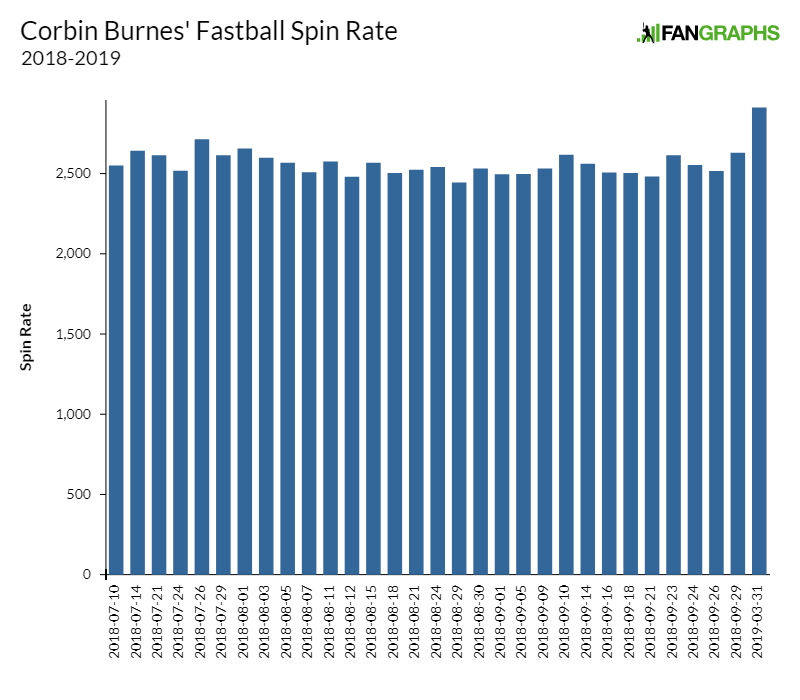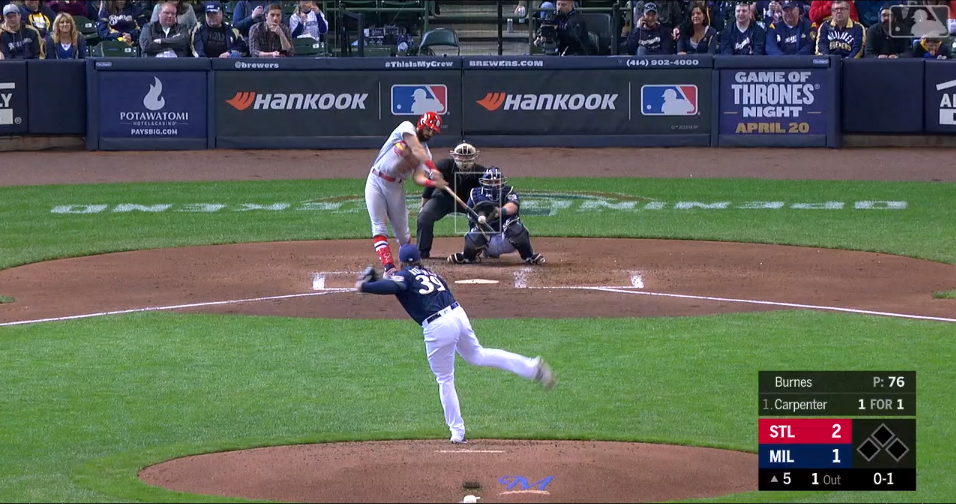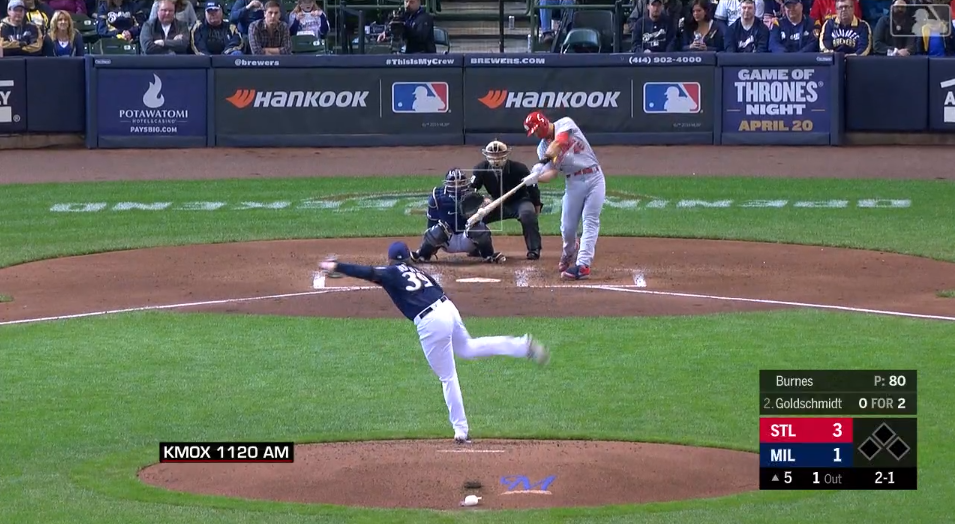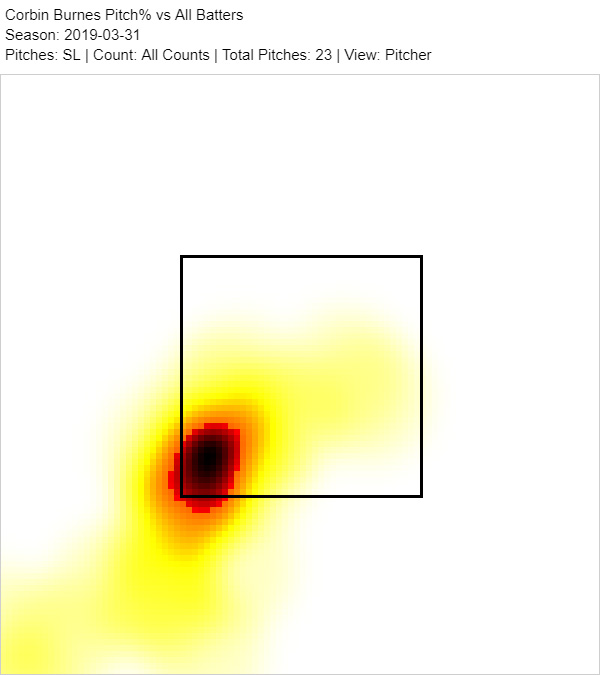Corbin Burnes Spins to Win
The first week of baseball is a wondrous time to be a baseball fan. It’s also a weird time to be a baseball writer. On one hand, baseball is happening, and that’s a relief after the long dark night of the offseason. On the other hand, not that much baseball has happened, and most of the seemingly noteworthy stories are small-sample noise. Give me an early-season take (Tim Beckham is great! Sandy Alcantara is a top-10 pitcher!), and I’ll likely dismiss it as a fluke. One performance this week, however, made me sit up and take notice. Corbin Burnes struck out 12 batters on Sunday, and the way he did it should have Brewers fans, and baseball fans in general, salivating.
At first glance, Burnes’ start against the Cardinals is a textbook case of not reading too much into a single start. He struck out 12 batters and walked only one, which is obviously incredible. On the other hand, he gave up three home runs and only lasted five innings, producing a what’s-going-on split of a 6.53 FIP and 0.00 xFIP. If I were a betting man, though, I’d wager that the strikeouts are more predictive than the home runs. Why? Corbin Burnes’ fastball was absolutely ludicrous, and in a way that you can’t fake.
Most of the things that happen in a baseball game are contextual. Did a pitcher strike a lot of hitters out? Well, consider who was batting. If it’s a bunch of high schoolers or the 2019 Giants outfield, that’s an extenuating circumstance. Did he give up a lot of home runs? A ton of factors go into that. One thing that isn’t contextual is a pitch’s spin rate. The batter doesn’t influence it. Pitch selection doesn’t influence it. It doesn’t take long to stabilize. It’s basically as clean as it gets in baseball statistics — you throw the ball, and you get your results.
When Burnes threw the ball on Sunday, the results were off the charts. Burnes fired 61 four-seam fastballs on Sunday. His velocity was down a tick or so from last year, when he worked out of the bullpen — nothing unusual about that. His spin, on the other hand, was wholly new. Burnes averaged 2912 rpm, and it’s hard to explain how crazy that is. It was nearly 150 rpm higher than last year’s league leader in average spin rate, Luke Bard. The fastball that Burnes spun most slowly, at 2660 rpm, would have been good for the second-highest fastball spin rate in baseball last year.
Burnes has always been a high-spin pitcher (11th in baseball among pitchers who threw at least 100 fastballs in 2018), but this is an entirely different level. Spin rates vary from start to start, but not like this. In fact, Burnes made thirty appearances last year, and the gap between the highest spin rate he recorded and the lowest was 270 rpm. Sunday’s start was 200 rpm faster than last year’s highest rate. Graphically, that looks pretty absurd, like so:

When I saw these numbers, the first thing I thought was that Statcast was broken. Burnes is out in front by so much that it’s hard to believe. Luckily, two Cardinals pitchers threw both in Sunday’s game and Monday’s (in Pittsburgh), so we’d likely be able to pick up any differences there. Jordan Hicks averaged 2052 rpm on his fastball on Sunday and 2077 on Monday. Andrew Miller went from 2070 Sunday to 2075 Monday. Want another data point? Josh Hader has averaged 2314 rpm at home this year and 2316 on the road. It certainly looks like Burnes’ spin numbers are real.
So what does that mean for Burnes’ 2019? The most obvious thing it means is more swinging strikes. The relationship between spin and whiffs is well-documented, and Burnes certainly showed swing-and-miss stuff on Sunday. The Cardinals swung at 27 four-seamers and missed nine. The 15% swinging strike rate (and 33% whiffs per swing) on his fastball would have been near the top of baseball last year, and this is a leaderboard you want to be on: the top five in order are Hader, Sean Doolittle, Jacob deGrom, Craig Kimbrel, and Chris Sale.
Another takeaway from this start is that Burnes might want to tinker with his fastball location. Take a look at where deGrom throws his four-seam fastball:

That’s essentially the textbook place to throw a high-spin fastball. Batters are likely to get under the pitch, and getting under a pitch at the top of the zone is exactly what the pitcher wants. Take a look at Burnes’ heat map and you’ll see one glaring problem:

That lower cluster of pitches? You don’t want that. You really, really don’t want that. Take a look at the location of the pitch Matt Carpenter hit for a home run:

Not convinced? Well, my skeptical friend, take a look at the last pitch of the very next at-bat, which Paul Goldschmidt sent on a very very long ride:

Still, somehow, not convinced? I mean, maybe consider being less skeptical, but fine, here’s some more evidence. Burnes threw 23 four-seam fastballs in the lower two-thirds of the strike zone. He generated exactly two whiffs on those pitches, and given that Michael Wacha took the second of those two swings, one barely counts. Even on a day in which Burnes had 12 strikeouts, he got essentially nothing out of these low fastballs. Take those pitches out of the equation, and he might have put up a more dominant pitching line.
High-spin fastballs low in the zone are nothing new for Burnes. In 2018, he was similarly down in the zone and similarly didn’t generate many swings and misses for someone with such good stuff. If you’re looking for an encouraging note, however, consider this: in 2018, roughly 40% of the fastballs Burnes threw in the strike zone were in the lower third. In Sunday’s start, the number dipped close to 30%. Conversely, only about 25% of his zone fastballs were in the upper third in 2018 — he raised that up near 40% on Sunday. In short, Burnes is throwing higher in the strike zone this year, matching pitch location to the best attributes of his fastball.
It’s a testament to the sheer outlandishness of Burnes’ four-seam fastball that it took this long into an article to talk about his slider, but that offering was impressive on Sunday as well. It was as close to unhittable as a major league pitch gets — the Cardinals swung at eleven sliders and missed eight. He wasn’t just spiking them into the ground and hoping for a swing, either — he threw 10 sliders in the strike zone, and the Cardinals could only muster two foul balls and a weak grounder on those.
What made his slider so effective? You guessed it — his spin rate has spiked so far this year. While it wasn’t quite as absurd of a spin increase as his fastball had, the slider would still have had the second-highest average spin rate of all 2018 sliders. On this pitch, however, Burnes had the location to match the pitch shape:

As Eric Longenhagen noted last year, Burnes has tremendous glove-side command of his slider. He’s putting that to good use so far this year, and the combination of location and stuff certainly played on Sunday. Burnes won’t go all of 2019 without allowing a hit against his slider, but if he continues to locate it like he did in this start, it’s going to be a devastating pitch.
As I mentioned at the top, it’s too early in the season to draw conclusions. Maybe Burnes had an out-of-body experience he’ll never repeat. Maybe despite all evidence to the contrary, the Statcast spin numbers were just wrong. Heck, we don’t exactly have to get that far into maybes to cast doubt on his performance — he left the game down 4-1 and has negative WAR right now. That’s all noise, though. Giving up home runs to Paul DeJong, Carpenter, and Goldschmidt? Loud noise, but noise. The spin is real, and the spin is spectacular. The Brewers desperately need starting pitching in 2019, and even after just one start, Burnes looks like he might be the answer.
Ben is a writer at FanGraphs. He can be found on Bluesky @benclemens.

Fantastic deep dive and kudos to the Brewers for giving him a spot in the rotation.